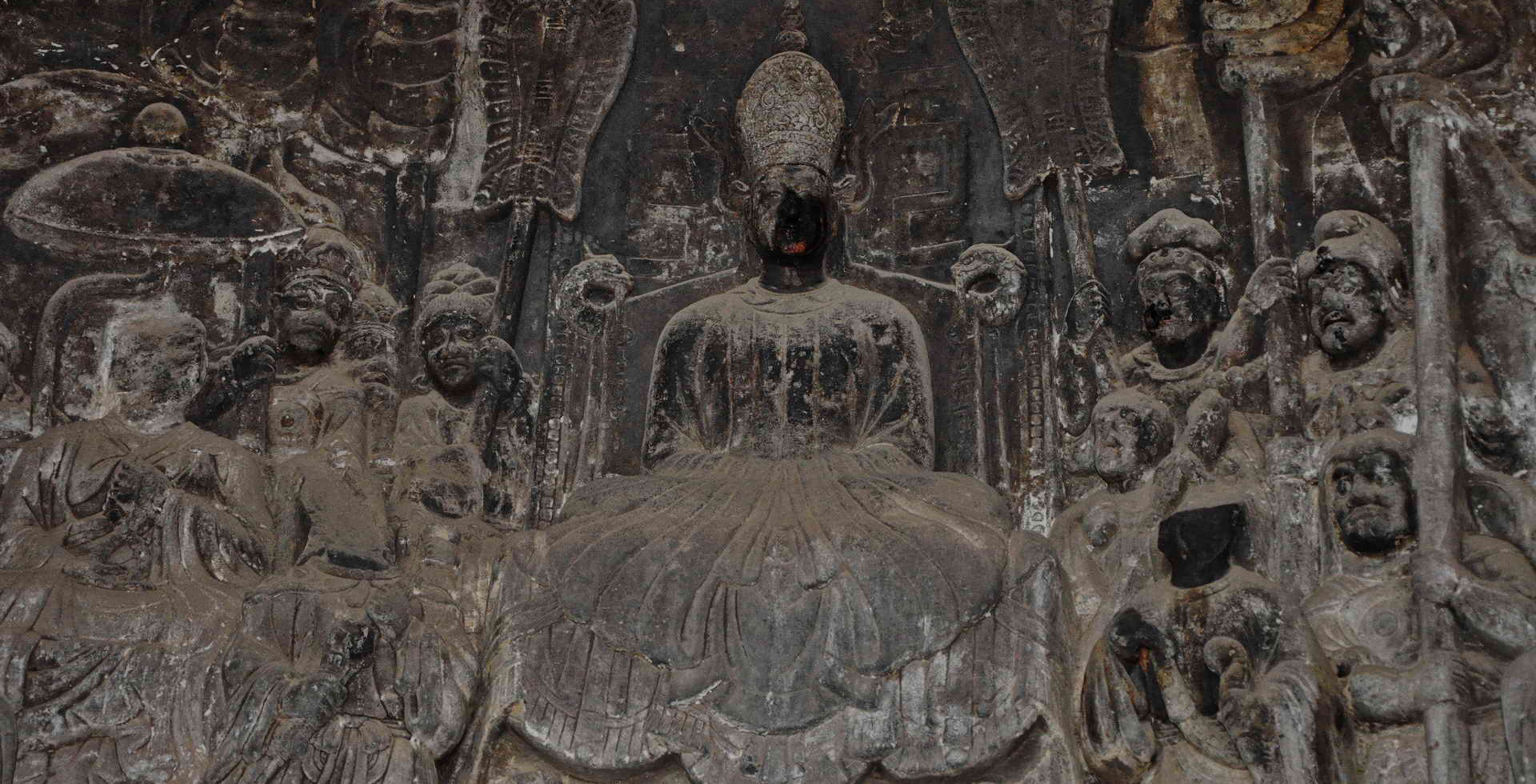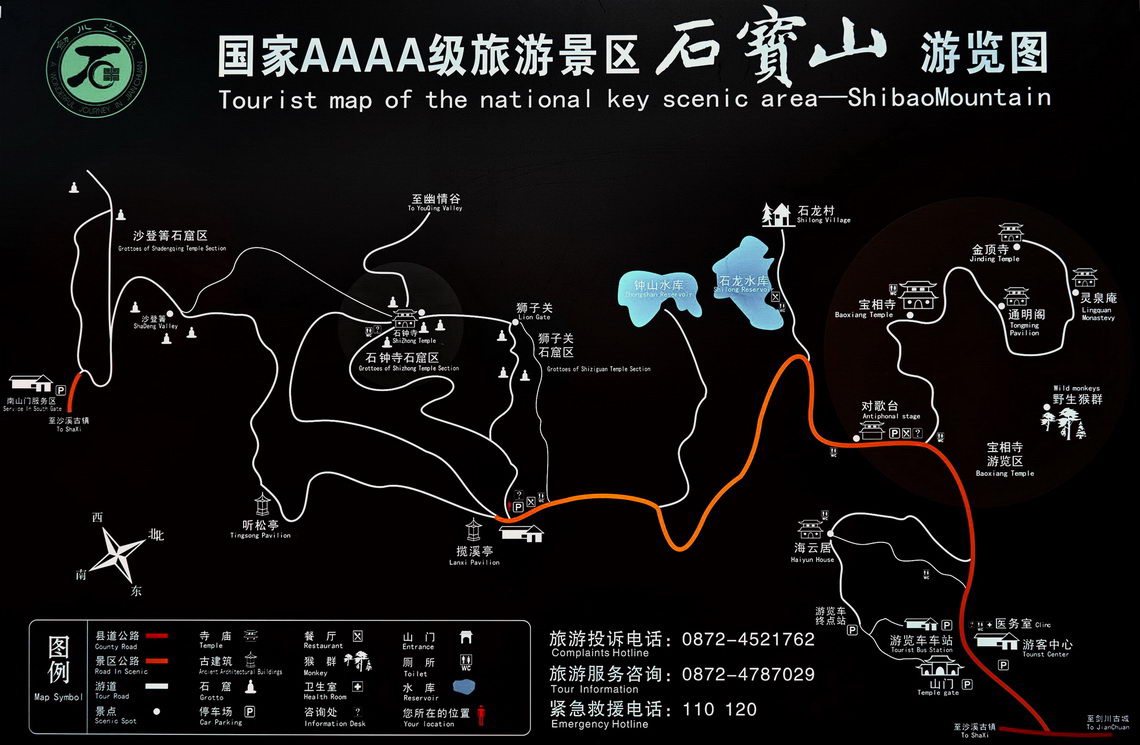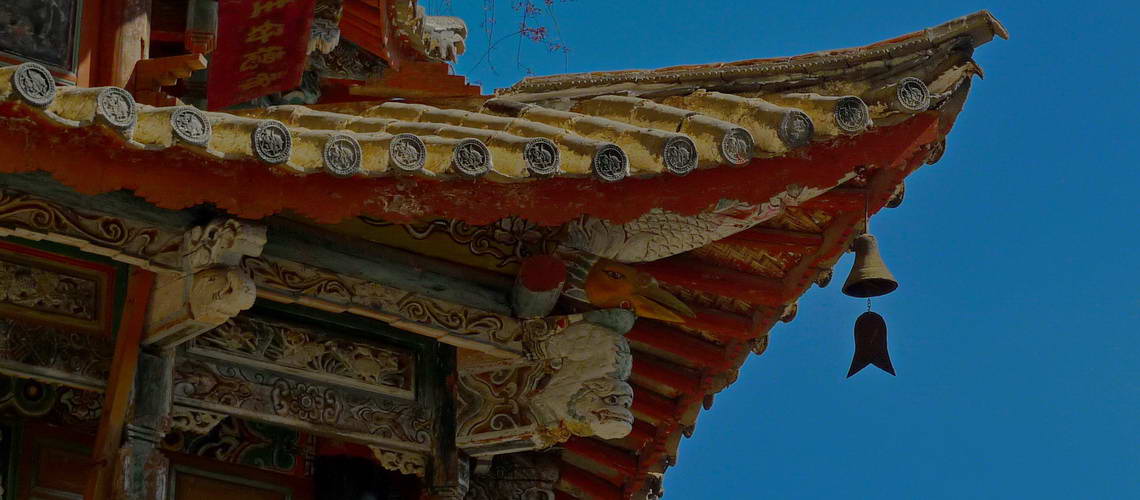
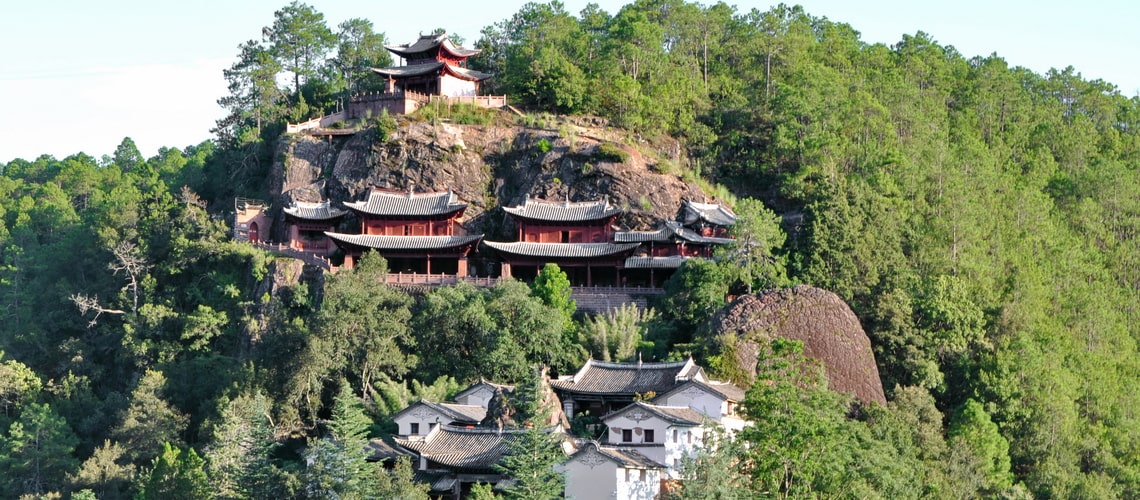
The centerpiece attraction of Shaxi
Shibaoshan (Stone Treasure Mountain) lies about 10km north of Shaxi on the road to Jianchuan, and was one of the very first nature reserves and religious sites to be officially protected in China back in 1982. The 2000 hectare area is made up of three separate mountains reaching up to a height of 3083 meters, known as Mount Baoding, Mount Shisan and Mount Shizhong, along with four temples; Shizhong Temple, Baoxiang Temple, Haiyun Temple, and Jinding Temple. Thanks to the areas remoteness, the temples and grottoes miraculously survived the destruction of the Cultural Revolution. The geology here is a known as a danxia land-form, made up mainly of red sand stone and conglomerates dating back to the cretaceous period. In some places the formations resemble a tortoise' s back, caused by cascades of water running along it, similar to the erosion seen at the site of the Sphinx in Giza. The Shibaoshan rock carvings are over 1300 years old and valuable historical evidence of the spread of Mahayana Buddhism into Yunnan from Tibet. Gentle winds from the south push the clouds up until they circle the peaks, giving the impression that many of the temples and grottoes are floating in the ether, abodes of the gods that are literally suspended from the heavens.
Mini buses take about forty minutes to the main Shibaoshan turn off, but a better option is to hike up into this beautiful area of forests and scattered temples. Just after the gas station on the left of the main road, look for kilometer mark 113, and turn left (west) onto a dirt road. From there it takes about twenty minutes to reach the southern edge of the Shibaoshan area and about another two hours up into the mountains to reach the main Shizhong Temple. The entrance fee is 50 yuan. This area receives surprisingly few visitors, and the result is pristine hiking country with virtually no crowds. Even the most energetic of hikers will probably need three days to explore all of the beautiful scenery, but please be aware that flash photography in the grottoes can damage the long term integrity of these ancient carvings.
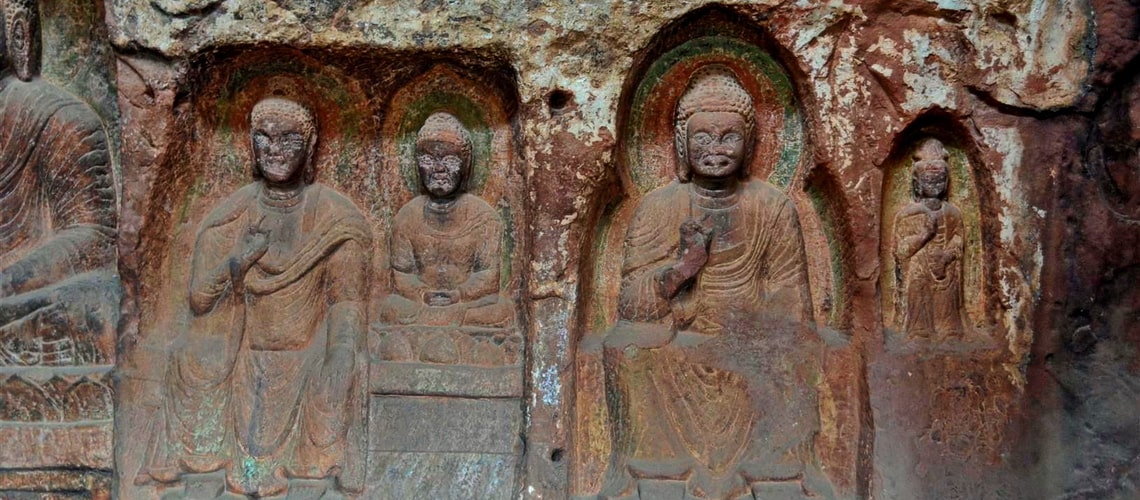
A hidden ancient wonder of China
In total there are seventeen grottoes, comprising of 140 carvings with the highest concentration around Shizhong (pronounced shur-johng) Temple (Stone Bell Temple), named after the huge bell shaped sandstone outcrop upon which it it is located. Historical documents speak of other as yet discovered grottoes, and so look out for surprises while you are exploring.
The carvings found here are not only some of the oldest in China but some of the most exquisite. Delicate stonework featuring, vivid images, unique meanings and strong local ethnic features. Perhaps the most noteworthy is the Yoni Shrine, a cleft in the cliffside that bears much more than a passing resemblance to the female genitalia, with a constant stream of mountain water flowing across its form. While unique in Buddhist religious sites, scholars suggest that this is related to the Bai matriarchal traditions, and it is still used by women today, who come here to pray for fertility and smooth childbirth.
Other grottoes feature the history of the Nanzhao kingdom, with detailed court scenes of the early kings, as well as rare representations of foreign emissaries including Indian monks and Persian dignitaries. There is even six trunked elephant in there, waiting to be properly interpreted. Such portrayals are so unusual in witnessing the historical contact between Yunnan and the rest of Asia, that the grottoes were the very first listed as National Major Cultural Relics under the State Protection level in 1961.
There are other grottoes in the Shadeng Valley and Lion's Gate Pass, with the most interesting of these being the nightmarish Black Heavenly God.
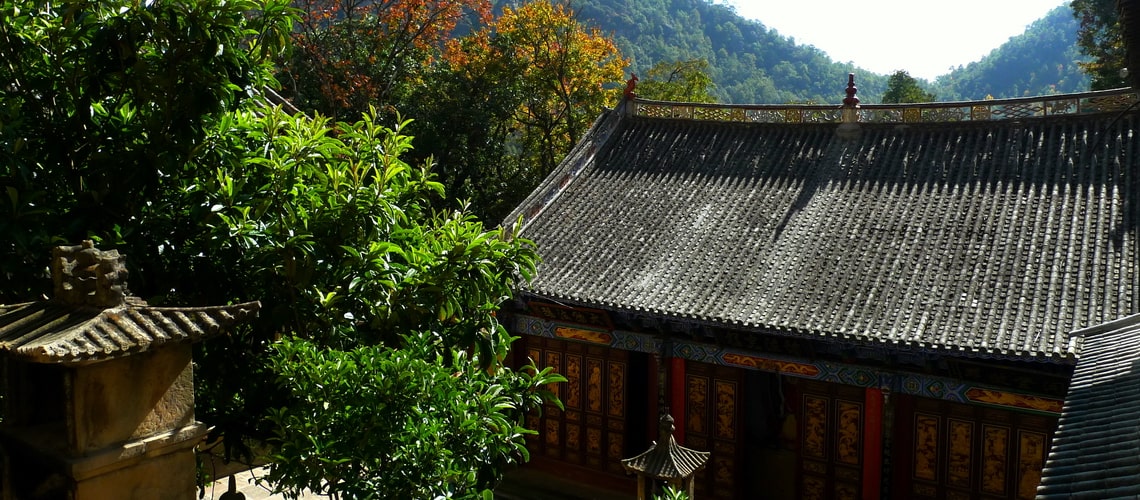
Monkeys and lots of stairs
Located a short walk away from the main temples, the just above the main stage area of the singing festival, the cliff structures at Baoxiang are visually impressive, if maybe a little daunting for those with a fear of heights. There are cascades, sky ladders and floating bridges, as well as representations of at least a dozen different Buddhas, but try to choose a quiet day to explore as there are thousands of stone steps and some of them can be a bit narrow for passing purposes. Constructed in the Yuan dynasty (around 1291 A.D.) this small but striking cluster is made up of the Baoxiang Temple, the Tongming Pavilion, Linqun'an and the Jingding Temple. Climb the ninety-nine steps to reach the Jinding Temple for the sunrise and then take the path north to see the Bat Cave and Haiyun Temple. The forest here is home to a troupe of territorial but tolerant macaques, who have learned to socialize amicably with most visitors, especially with those who bring picnic lunches and other edible treats.
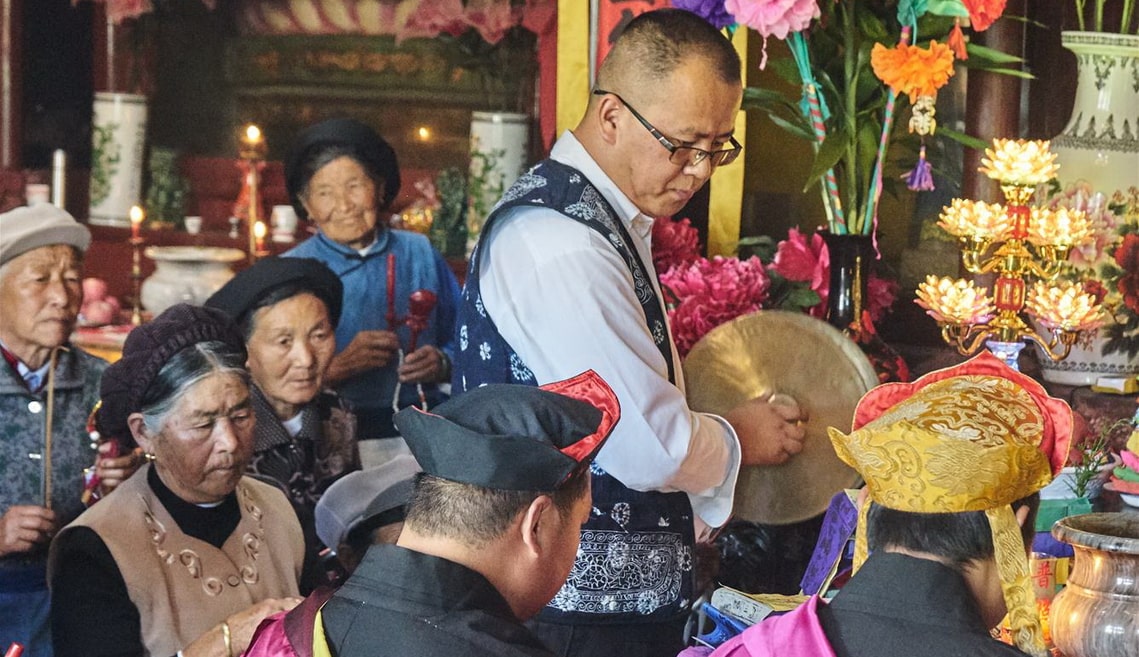
The Hai Yun Ju Nunnery (Sea of Clouds Abode 海云居) is a lively functioning temple and features many sacred rooms, shrines and intact buildings. It is not listed on the tourist maps but is well worth an hour's visit at least. There are rooms for accommodation, a vegetarian kitchen serving simple meals and a garden where much of the food is grown. The Nunnery sill has resident nuns, but many more will come for festivals and events to chant prayers. Hai Yun Ju is looked after by elder Bai women, mostly from Shilong Village nearby, who keep the candles and incense burning while a few men keep track of donations. The caretakers are all very friendly and will invite visitors to have tea or a meal. In the main hall is a 6 meter white jade Buddha from Burma who pilgrims come to worship from far away.
Haiyun temple is the first temple encountered at the Shibaoshan area. Dating back to the 17th century, the Chan Buddhist temple is important for local Bai minority people, but this secluded templed is often overlooked by visitors seeking monkeys, cliff temples or ancient symbolic stone carvings found further into the Shibaoshan area. Located on the left after the ticket office entrance, Haiyun is tucked away on the north-west forested flanks of Stone Umbrella mountain. As well as the ancient temple complex hidden among the trees behind the moss-covered walls, there are stupas, stone urn tombs, caves with bats, red rock formations resembling umbrellas and old tall trees. Two elderly matriarch caretakers add to the olde-worlde feel of the historic buildings. Wild camellia trees grow around the temple, meaning the temple and nunnery is also known as the Camellia Temple. You can even make fresh tea with the leaves. The lovingly-tended gardens in the grounds provide a spectacle throughout the year.
Low, narrow stone stairs lead to the traditional stone gateway that greets visitors with an old classic Buddhist poem carved into the rock. Further along a few more steps, century-old cypress trees stand by the main entrance to the temple, their branches used as incense. The entranceway is guarded by two scary-looking Tibetan Buddhist door gods, Heng and Ha. Because of Dali's location and proximity to the direct teachings of the Buddha and the spread of Buddhism through Tibet into the Chinese borderlands, these temple bouncers are found in most Buddhist temples throughout the Bai minority areas around Dali.
As you walk into the temple complex, there is a happy Buddha with a chubby belly, seating in the middle. The second hall features four figures, representing the four directions of the Universe.. Known as the Four Heavenly Kings, each is holding a powerful magic tool. Follow the stairs to the first garden, turn left and you will reach the second floor, directly above the four direction gods. The 'fengshui' of this place is very good. On a clear, sunny day, you can see in the distance the glistening snowy peaks of the Jade Dragon Snow mountain near Lijiang.
Prominent in this part of the temple is Guanyin, the goddess of mercy, compassion and kindness. She appears in white holding a vase in one hand, and willow branches in her other hand. Many Bai women and children come to pray to her. On the left of Guanyin are two goddess figures. One sitting on an elephant is the goddess of actions and deeds. The other sitting on a green lion is the goddess of wisdom, holding a book in one hands and a sword on the other to cut off all desires and troublesome thoughts. Throughout China, there are four goddesses, but in this temple there are only three, with the goddess of will and wishful thinking not represented. In the right corner, is the figure of the monk Tangseng, a key person in the spread of Buddhism from India to China. A skilled language scholar, he was asked by the Tang Dynasty Chinese emperor to travel to India with the monkey king to fetch the first Buddhist scriptures. He is regarded as the founder of one of the eight schools of Buddhism in China, the East Asia Yogacara school.
Walk on, past the garden, and in the hall above stands the tall, dark figure behind the glass of Guanyu, a warrior from the Eastern Han Dynasty (25AD-220AD). He was known as a brave fighter, who was also fair-minded, and was worshipped as the spirit of warfare. In China, he is often paired with the master of learning and knowledge, Confucius. Behind Guanyu is a garden which faces the main hall. The wooden sign says save yourself first to save others. The six-piece wooden carved doors tell the story of the rebellious monkey king before he ventured to India. On the left wall, there is a classic painting of the monk Pu Lian, with his student, who built this temple in 1684. Inside the main hall, there are three Buddha figures, the flanking images are quite old and made of clay, while the central Buddha is made from jade from Burma (Myanmar). Painted on the walls are the four-direction gods.
HISTORY
So how did Haiyun temple come into being almost 350 years ago? The story goes that during the Ming dynasty a travelling monk Chushi visited the area, and fell in love with the quiet of the majestic mountains around Jianchuan. A young man asked to be his student, and together they explored the area, finding an ideal place to found a temple and monastery in the hills. They collected funds, and the temple was finally opened in 1684. Abbot Chushi decided it was time for him to move on, so he left the student, Pu Lian, to be in charge. The remains of Pu Lian are held in the large stone urns outside the main gate.

